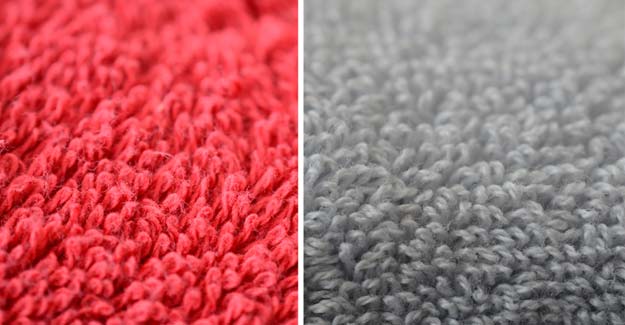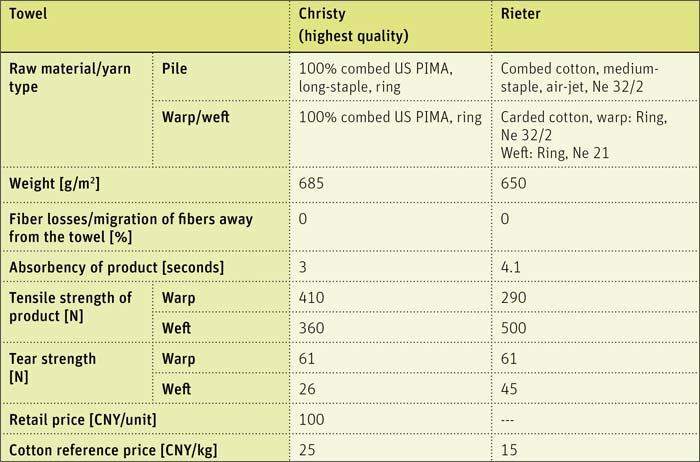
RIETER’s J 26 Has Significant Advantages
Air-jet quality yarns for high-quality terry towels
Thanks to the strong and stable production of combed cotton yarns, a new segment has opened up in China for the air-jet spinning machine J 26, as high-quality terry towels can be produced with this yarn, for example. That is not the only advantage, however.
For mills that want to produce air-jet cotton yarns, Rieter has the appropriate solution: the optimized spinning system and the technical and technological expertise. The mills benefit from low production costs and a quality of yarn significantly superior to that of competitors.
Cost and quality advantage in production
One of the largest Chinese mills carried out a comparison of the air-jet spinning machine J 26 with a competitor product over a period of six months. The J 26 convinced in a number of criteria.
[caption id="attachment_16677" align="alignnone" width="700"] Fig. 1 With slightly higher production, the Com4®jet yarn of the J 26 achieves better yarn values and lower fiber loss on the air-jet spinning machine.[/caption]
The yarns spun on the J 26 at a higher production speed showed considerably better values for imperfections, evenness and strength (Fig. 1). The yarn hairiness was ideal for a soft touch with a low pilling tendency. The significantly lower fiber loss with the J 26 allows the mill an excellent raw material yield and this achieve annual cost savings of around 17 tons of cotton per air-jet spinning machine (basis of calculation: J 26 with 120 spinning units, yarn count Ne 32, delivery speed 420 m/min).
From the idea to the product
In China a middle class with high purchasing power emerged, that continues to grow. This lucrative consumer group is prepared to spend more money on high-quality products. Statistics confirm a strong growth in products in the higher price bracket.
Based on the properties of the Com4®jet yarn, the yarn of the J 26, an idea emerged of creating terry towels that meet the following criteria:
Fig. 1 With slightly higher production, the Com4®jet yarn of the J 26 achieves better yarn values and lower fiber loss on the air-jet spinning machine.[/caption]
The yarns spun on the J 26 at a higher production speed showed considerably better values for imperfections, evenness and strength (Fig. 1). The yarn hairiness was ideal for a soft touch with a low pilling tendency. The significantly lower fiber loss with the J 26 allows the mill an excellent raw material yield and this achieve annual cost savings of around 17 tons of cotton per air-jet spinning machine (basis of calculation: J 26 with 120 spinning units, yarn count Ne 32, delivery speed 420 m/min).
From the idea to the product
In China a middle class with high purchasing power emerged, that continues to grow. This lucrative consumer group is prepared to spend more money on high-quality products. Statistics confirm a strong growth in products in the higher price bracket.
Based on the properties of the Com4®jet yarn, the yarn of the J 26, an idea emerged of creating terry towels that meet the following criteria:
- No pilling, even after a number of washing cycles
- Brilliant colors throughout the entire lifetime
- Quick absorption of moisture from the body
- No fluffing, no loss of fibers during washing
 Fig. 2 The Rieter towel made from 100% cotton was based on a fabric made from carded ring yarn and a loop made from combed air-jet yarn[/caption]
20 Rieter towels were given out to test persons to assess quality. Their feedback was univocal. Compared to the towels they currently used, they assessed the appearance and feel of the Com4®jet towels as Excellent. Water was absorbed quickly; the formation of lint and fluffing were minimal.
The independent Swiss test laboratory SGS was contacted for an neutral assessment. In addition to the Rieter towel, an extremely high-quality towel from the internationally renowned Christy brand was also provided to obtain reference data. From a purely visual perspective, both towels were comparable (Fig. 3).
[caption id="attachment_16679" align="alignnone" width="700"]
Fig. 2 The Rieter towel made from 100% cotton was based on a fabric made from carded ring yarn and a loop made from combed air-jet yarn[/caption]
20 Rieter towels were given out to test persons to assess quality. Their feedback was univocal. Compared to the towels they currently used, they assessed the appearance and feel of the Com4®jet towels as Excellent. Water was absorbed quickly; the formation of lint and fluffing were minimal.
The independent Swiss test laboratory SGS was contacted for an neutral assessment. In addition to the Rieter towel, an extremely high-quality towel from the internationally renowned Christy brand was also provided to obtain reference data. From a purely visual perspective, both towels were comparable (Fig. 3).
[caption id="attachment_16679" align="alignnone" width="700"] Fig. 4 The data collected by the independent test laboratory SGS confirmed that Com4®jet yarns are perfect for high-quality towels[/caption]
The test results showed that the Rieter towel with air-jet cotton yarn in the pile performed very well. No fibres were lost – in other words: there was no fluffing. The Rieter towel kept its volume for a long time, as the pile remained upright and also retained its softness. The tensile strength and therefore the wear resistance were also excellent. The absorbency was almost at the level of the reference product and therefore corresponded to a very high level within the standard. Particularly interesting were the raw material costs. The yarn of the Rieter towels was spun from medium-staple cotton. This saves around 40% on raw material costs compared to the long-staple cotton used in the Christy towel.
This study has shown that the Rieter air-jet spinning technology produces cotton yarns of a very high quality. Used correctly, the air-jet yarns can play to their strengths. The results are very attractive end products. In addition, a mill saves considerable raw material costs.
The interest in air-jet cotton yarns is growing. An increasing number of spinning mills and downstream users are developing products and benefit from the modern J 26 air-jet spinning technology and its special yarn properties.
Fig. 4 The data collected by the independent test laboratory SGS confirmed that Com4®jet yarns are perfect for high-quality towels[/caption]
The test results showed that the Rieter towel with air-jet cotton yarn in the pile performed very well. No fibres were lost – in other words: there was no fluffing. The Rieter towel kept its volume for a long time, as the pile remained upright and also retained its softness. The tensile strength and therefore the wear resistance were also excellent. The absorbency was almost at the level of the reference product and therefore corresponded to a very high level within the standard. Particularly interesting were the raw material costs. The yarn of the Rieter towels was spun from medium-staple cotton. This saves around 40% on raw material costs compared to the long-staple cotton used in the Christy towel.
This study has shown that the Rieter air-jet spinning technology produces cotton yarns of a very high quality. Used correctly, the air-jet yarns can play to their strengths. The results are very attractive end products. In addition, a mill saves considerable raw material costs.
The interest in air-jet cotton yarns is growing. An increasing number of spinning mills and downstream users are developing products and benefit from the modern J 26 air-jet spinning technology and its special yarn properties.

Textile Excellence
If you wish to Subscribe to Textile Excellence Print Edition, kindly fill in the below form and we shall get back to you with details.








